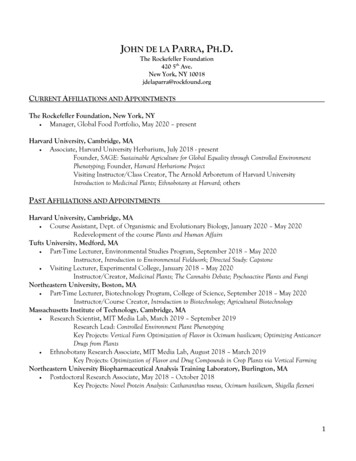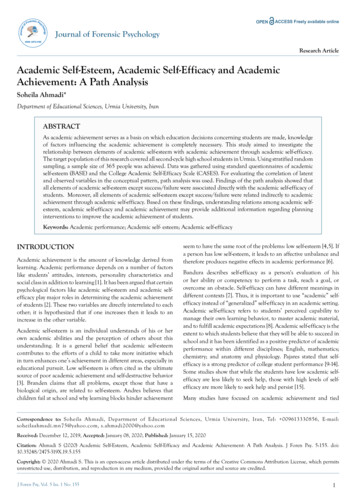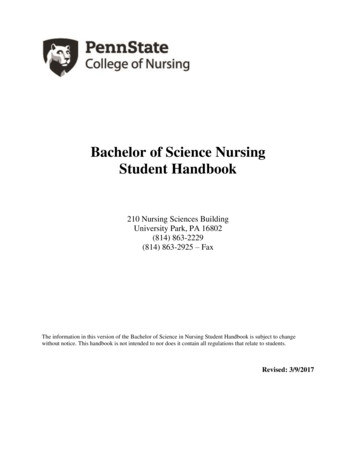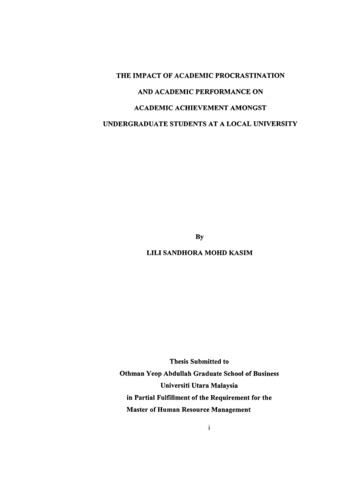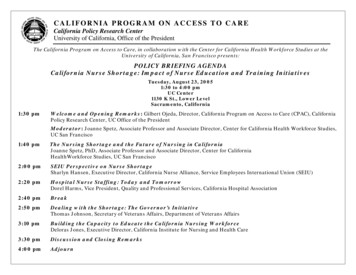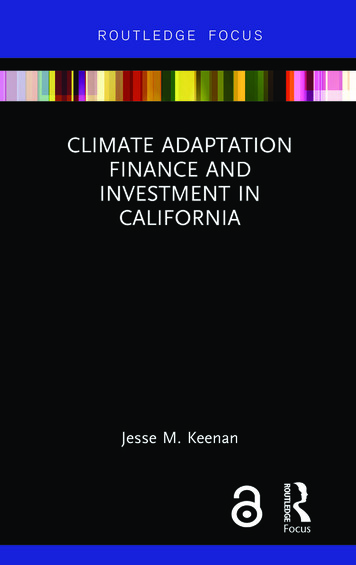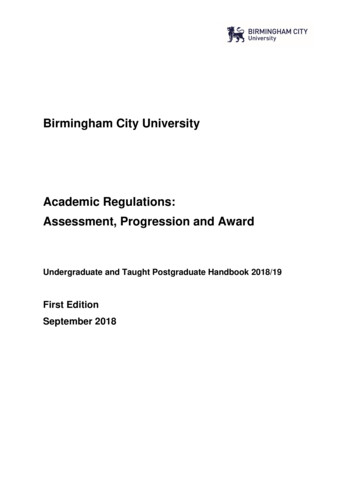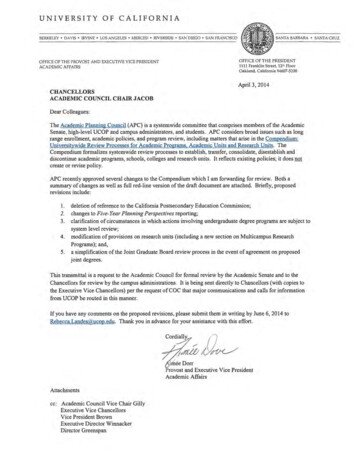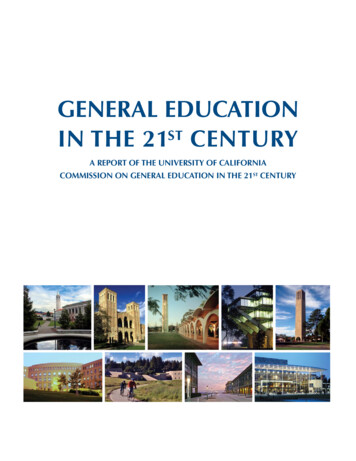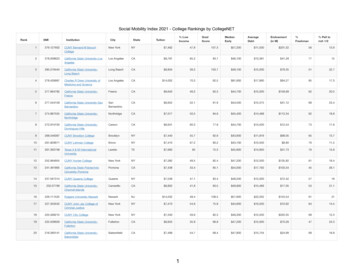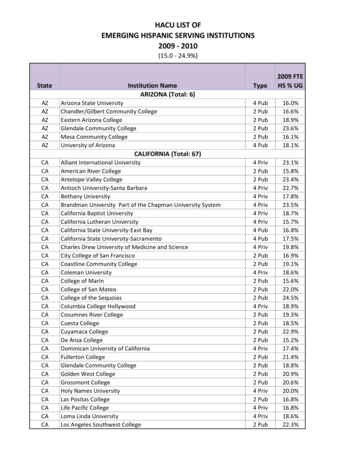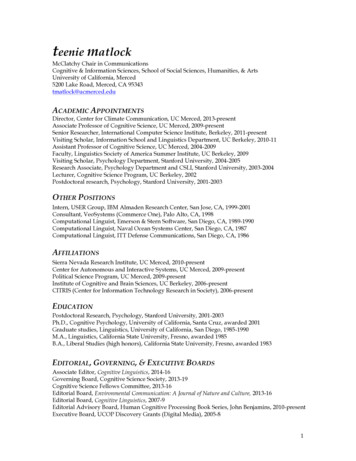
Transcription
teenie matlockMcClatchy Chair in CommunicationsCognitive & Information Sciences, School of Social Sciences, Humanities, & ArtsUniversity of California, Merced5200 Lake Road, Merced, CA 95343tmatlock@ucmerced.eduACADEMIC APPOINTMENTSDirector, Center for Climate Communication, UC Merced, 2013-presentAssociate Professor of Cognitive Science, UC Merced, 2009-presentSenior Researcher, International Computer Science Institute, Berkeley, 2011-presentVisiting Scholar, Information School and Linguistics Department, UC Berkeley, 2010-11Assistant Professor of Cognitive Science, UC Merced, 2004-2009Faculty, Linguistics Society of America Summer Institute, UC Berkeley, 2009Visiting Scholar, Psychology Department, Stanford University, 2004-2005Research Associate, Psychology Department and CSLI, Stanford University, 2003-2004Lecturer, Cognitive Science Program, UC Berkeley, 2002Postdoctoral research, Psychology, Stanford University, 2001-2003OTHER POSITIONSIntern, USER Group, IBM Almaden Research Center, San Jose, CA, 1999-2001Consultant, VeoSystems (Commerce One), Palo Alto, CA, 1998Computational Linguist, Emerson & Stern Software, San Diego, CA, 1989-1990Computational Linguist, Naval Ocean Systems Center, San Diego, CA, 1987Computational Linguist, ITT Defense Communications, San Diego, CA, 1986AFFILIATIONSSierra Nevada Research Institute, UC Merced, 2010-presentCenter for Autonomous and Interactive Systems, UC Merced, 2009-presentPolitical Science Program, UC Merced, 2009-presentInstitute of Cognitive and Brain Sciences, UC Berkeley, 2006-presentCITRIS (Center for Information Technology Research in Society), 2006-presentEDUCATIONPostdoctoral Research, Psychology, Stanford University, 2001-2003Ph.D., Cognitive Psychology, University of California, Santa Cruz, awarded 2001Graduate studies, Linguistics, University of California, San Diego, 1985-1990M.A., Linguistics, California State University, Fresno, awarded 1985B.A., Liberal Studies (high honors), California State University, Fresno, awarded 1983EDITORIAL, GOVERNING, & EXECUTIVE BOARDSAssociate Editor, Cognitive Linguistics, 2014-16Governing Board, Cognitive Science Society, 2013-19Cognitive Science Fellows Committee, 2013-16Editorial Board, Environmental Communication: A Journal of Nature and Culture, 2013-16Editorial Board, Cognitive Linguistics, 2007-9Editorial Advisory Board, Human Cognitive Processing Book Series, John Benjamins, 2010-presentExecutive Board, UCOP Discovery Grants (Digital Media), 2005-81
AWARDS, HONORS & ELECTED TITLESYoung Investigator Award (National Award, Sigma Xi), 2011Vice Chair, American Indian Council of Mariposa County, 2010-2013Distinguished Teaching Award (Undergraduate), UC Merced Academic Senate, 2008-9Distinguished Service Award, Sigma Xi, UC Merced Chapter, 2008-9Invited Faculty, Linguistics Society of America Summer Institute, 2009President, Sigma Xi, Merced Chapter, 2008-9Chapter of Excellence Award, Sigma Xi, 2008-9 (National Award)Vice President, Sigma Xi, Merced Chapter, 2007-8Chapter Outstanding Program Award, Sigma Xi, 2007-8 (national level award)Elected Charter member, Sigma Xi, Merced Chapter, 2007Invited faculty, Experimental Methods in Cognitive Linguistics Workshop, Cornell University, 2003Outstanding Teaching Award, Psychology Department, UC Santa Cruz, 1999Award for Dissertation Research, Psychology Department, UC Santa Cruz, 1999Graduate Fellowship, Psychology Department, UCSC, 1995-96San Diego Graduate & Opportunity Fellowship, Linguistics Department, UCSD, 1986-7, 1985-6U.S. PATENT ISSUEDCharacter Input Interface for Compact Electronic Devices, #6744427, issued 2004GRANTS AWARDEDExternal FundingNational Science Foundation, CNS-1305196, Acquisition of Sensors and Displays for Research onMotion Synthesis and Rehabilitation, 302,869 (total), Co-PI (PI Kallmann), 2013-16Intelligence Advanced Research Projects Agency, IARPA-BAA-11-04 Metaphor Program,MetaNet: A Multilingual Metaphor Extraction, Representation, and Validation System, 500,000(estimated) for UC Merced team, Senior Personnel (PI Narayanan, ICSI, Berkeley), 2012-17National Science Foundation, SMA-1251685, Workshop and Summer School on Dynamics ofLanguage and Music, 49,520 (total), Co-PI (PI Kello), 2012-13National Science Foundation, BCS-1031903, Levy Distributions in Foraging Games, ScenePerception, and Semantic Memory, 316,969 (total), Co-PI (PI Kello), 2010-12National Science Foundation, IIS-0915665, Parameterization and Collection of DemonstrativeGestures for Interactive Virtual Humans, 499,071 (total), Co-PI (PI Kallmann), 2009-12National Science Foundation, CNS-0723281 (Amendment), REU Supplement for MRI:Acquisition of Equipment to Establish a Cognitive Sensorium and Visualization Facility at UC Merced, 5,493 (total), Co-PI (PI Kallmann), 2008National Science Foundation, BCS-0821766 (MRI), Acquisition of Robotic Hardware for HumanoidResearch in Cognitive Science and Engineering, 476,500 (total), Co-PI (PI Carpin), 2008-11National Science Foundation, CNS-0723281 (MRI), Acquisition of Equipment to Establish a CognitiveSensorium and Visualization Facility, 255,493 (total), Co-PI (PI Kallmann), 2007-10National Science Foundation, BCS-0617714, Future of Cognitive Science Conference, 26,174 (totalcosts), PI, 20062
Internal FundingUniversity of California Humanities Research Institute Conference Development Grant, AnInterdisciplinary Approach to Exploring the Human Experience and Conceptualization of Caves, 8,000,Co-PI (PI Moyes), 2012Center for Research in the Humanities and Arts, UC Merced, Conference Development Grant, AnInterdisciplinary Approach to Exploring the Human Experience and Conceptualization of Caves, 12,000,Co-PI (PI Moyes), 2011University of California, Merced Collaborative Research Grant, Center for Research in theHumanities and the Arts, Cognition and Caves Faculty Workgroup Grant, 4,610, Co-PI (PI Moyes), 2010University of California Discovery Grant, Cognitive Animation Conference, 14,200, Co-PI(other Co-PI Kallmann), 2007Graduate Research Council, Shared Equipment Grant, 950, PI, 2006Graduate Research Council, Faculty Research Grant, 1,100, PI, 2006University of California Office of the President Grant, UC Merced Cognitive SciencePlanning Workshop, 2,000, Co-PI (PI Shadish), 2004PROFESSIONAL ORGANIZATIONSAmerican Indian Science and Engineering SocietyAmerican Psychological SocietyCognitive Science SocietyInternational Environmental Communication AssociationInternational Cognitive Linguistics AssociationLinguistics Society of AmericaSigma Xi, the Scientific Research SocietyTEACHINGCoursesCOGS 5, Introduction to Language and Linguistics, UC Merced, Spring 2014, 2012, 2010, 2007COGS 159, Metaphor and Thought, UC Merced, Fall 2013, 2012, 2009COGS 90x, Music and the Brain, UC Merced, Fall 2011LSA 112, Experimental Semantics, UC Berkeley, Summer 2009 (LSA Summer Institute)COGS 1, Introduction to Cognitive Science, UC Merced, Fall 2008, 2007, 2006, 2005COGS 180, Topics in Cognitive Science (“Language & Cognition”), UC Merced, Spring 2006COGS 250, Mind, Technology, and Society, UC Merced, Fall 2013, Fall 2011, 2008, 2007, 2006COGS 1, Introduction to Cognitive Science, UC Berkeley, Summer 20023
ADVISING & MENTORING2012 to 2014Advising Graduate StudentsJustin Matthews, UCM Cognitive and Information Sciences (sole advisor)Bodo Winter, UCM Cognitive and Information Sciences (sole advisor)Till Bergmann, UCM Cognitive and Information Sciences (primary advisor; Dale secondary)Patricia Lichtenstein, UCM Cognitive and Information Sciences (secondary advisor; Spivey primary)Morgan Fleming, UCM Cognitive and Information Sciences (secondary advisor; Maglio primary)Sam Spevak, UCM Cognitive and Information Sciences (secondary advisor; Spivey primary)David Vinson, UCM Cognitive and Information Sciences (secondary advisor; Dale primary)Stephanie Huette, UCM Cognitive and Information Science (PhD 2013; Spivey primary)Serving on Dissertation and Thesis CommitteesShana Erickson, UCM Cognitive and Information SciencesAlexandra Paxton, UCM Cognitive and Information SciencesTyler Marghetis, UC San Diego Cognitive ScienceEsther Walker, UC San Diego Cognitive ScienceShweta Narayan, UC Berkeley LinguisticsCorrine Occhino Kehoe, University of New Mexico LinguisticsPaola Di Giuseppantonio Di Franco, UCM World Cultures (PhD 2014)Fabrizio Galleazzi, UCM World Cultures (PhD 2014)David Huang, UCM Electrical Engineering and Computer Science (PhD 2013)Trent Kriete, UCM Cognitive Science (PhD 2010)Michelle Gumbrecht, Stanford University Psychology (PhD 2006)Carl Ponzio, UCM Spanish Literature (MA 2013)Michael Romano, UCM Cognitive Science (PhD 2011)Advising Postdoctoral ResearchersDr. Timothy Gann, UCM Center for Climate Communication and Sierra Nevada Research InstitutePerlman, Marcus, UCM Cognitive and Information Sciences (2012-2013)Mentoring Research Associates researchers with recently completed BA or BSJ.P. Gonzales, UCM Center for Climate Communication and Sierra Nevada Research InstituteA.J. Montoya, UCM Cognitive and Informative Sciences (starting Fall 2014)Spencer Castro, UCM Cognitive and Informative Sciences (2011-2013)Jeremy Hunter, UCM Cognitive Science (2009)Krysta Varner, UCM Social Sciences, Humanities, and Arts (2004-2006)Mentoring Assistant ProfessorsDalia Magana, UCM World Cultures (Spanish Linguistics)Anne Warlamount, UCM Cognitive and Information Sciences4
PUBLICATIONSPeer-reviewed ArticlesHuette, S., & Matlock, T. (to appear). Figurative language processing: Fictive motion and thevisual world. In P. Pyykkonen & M. W. Crocker (Eds.), Visually Situated Language Comprehension.Matlock, T., & Bergmann, T. (to appear). Fictive motion. In E. Dąbrowska & D. Divjak (Eds.)Handbook of Cognitive Linguistics. DeGruyter Mouton.Gann, T., & Matlock, T. (in press). The semantics of climate change and global warming.Proceedings of the 36th annual meeting of the Cognitive Science Society. Austin, TX: Cognitive ScienceSociety.Winter, B., Perlman, M., & Matlock, T. (in press). Using space to talk and gesture about numbers:Evidence from the TV News Archive. Gesture.Huette, S., Winter, B., Matlock, T., Spivey, M.J., & Ardell, D. (2014). Eye movements duringlistening reveal spontaneous grammatical processing. Frontiers in Cognitive Science.Vinson, D.W., Abney, D.H., Dale, R., & Matlock, T. (2014). High-level context effects on spatialdisplacement: The effects of body orientation and language on memory. Frontiers in CognitiveScience.Anderson, S., Matlock, T., & Spivey, M.J. (2013). Grammatical aspect and temporal distance inmotion descriptions. Frontiers in Cognitive Science.Matlock, T., & Winter, B. (2013). Experimental semantics. Oxford Handbook of Linguistic Analysis.Oxford University Press.Matlock, T. (2013). Motion metaphors in political races. In M. Borkent, B. Dancygier, and J.Hinnell (Eds.), Language and the creative mind (pp. 193-201). Stanford, CA: CSLI Publications.Winter, B., & Matlock, T. (2013). Creativity and the sensorimotor grounding of mathematics. InM. Borkent, B. Dancygier, and J. Hinnell (Eds.), Language and the creative mind (pp.37-48).Stanford, CA: CSLI Publications.Winter, B., & Matlock, T. (2013). Making judgments based on similarity and proximity. Metaphor &Symbol, 28, 1-14.Winter, B., & Matlock, T. (2013). More is up and right: Random number generation along twoaxes. Proceedings of the 35th annual meeting of the Cognitive Science Society. Austin, TX: CognitiveScience Society.Flores, C., Matlock, T., & Dávila, L.P. (2012). Enhancing materials research through innovative3D environments and interactive manuals for data visualization and analysis. MRS Proceedings,1472, mrss12-1472-zz01-03 doi:10.1557/pol.2012.1257.Huette, S., Winter, B., Matlock, T., & Spivey, M. (2012). Processing motion implied in language:Eye-movement differences during aspect comprehension. Cognitive Processing, 13, 193-197.Matlock, T. (2012). Framing political messages with grammar and metaphor. American Scientist,100, 478-483.5
Matlock, T., Sparks, D., Matthews, J.L., Hunter, J., & Huette, S. (2012). Smashing new results onaspectual framing: How people describe car accidents. Studies in Language, 36, 700-721.Doblack, B., Flores, C., Matlock, T., & Dávila, L. (2011). The Emergence of Immersive Low-Cost3D Virtual Reality Environments for Interactive Learning in Materials Science and Engineering.MRS Proceedings, 1320, mrsf10-1320-xx04-01 doi:10.1557/opl.2011.636Fausey, C.M., & Matlock, T. (2011). Can grammar win elections? Political Psychology, 32, 563–574.Huang, Y., Matthews, J.L., Matlock, T., & Kallmann, M. (2011). Modeling gaze behavior forvirtual demonstrators. In H. Högni Vilhjálmsson et al. (Eds.), Proceedings of the 11th InternationalConference on Intelligent Virtual Agents, Reykjavík, Iceland, LNAI 6895 (pp. 155-161).Berlin/Heidelberg: Springer-Verlag. doi:10.1007/978-3-642-23974-8 17Huette, S., Anderson, S., Matlock, T., & Spivey, M.J. (2011). A one-stage distributed processingaccount of linguistic negation. Proceedings of the 33rd annual meeting of the Cognitive Science Society(pp. 2037-2042). Austin, TX: Cognitive Science Society.Huette, S., Huang, Y., Kallmann, M., Matlock, T., & Matthews, J.L. (2011). Gesture variants andcognitive constraints for interactive virtual reality training systems. Proceedings of the 2011International Conference on Intelligent User Interfaces. ACM press.Matlock, T. (2011). The conceptual motivation of aspect. In K. Panther and G. Radden (Eds.),Motivation in Grammar and the Lexicon (pp. 133-147) Amsterdam: Philadelphia: John Benjamins.Matlock, T., Holmes, K.J., Srinivasan, M., & Ramscar, M. (2011). Even abstract motion influencesthe understanding of time. Metaphor and Symbol, 26, 260-271.Matthews, J.L., & Matlock, T. (2011). Understanding the link between spatial distance and socialdistance. Social Psychology, 42, 185-192.Anderson, S., Huette, S., Matlock, T., & Spivey, M.J. (2010). Comprehending negated sentenceswith binary states and locations. Proceedings of the 32nd annual meeting of the Cognitive ScienceSociety (pp.1192-1197). Austin, TX: Cognitive Science Society.Anderson, S., Huette, S., Matlock, T., & Spivey, M.J. (2010). On the temporal dynamics of negatedperceptual simulations. In F. Parrill, V. Tobin, and M. Turner (Eds.) Meaning, Form, and Body.CSLI Press.Anderson, S., Matlock, T., & Spivey, M.J. (2010). On-line interactions of context and grammaticalaspect. Proceedings of the 32nd annual meeting of the Cognitive Science Society (pp. 1198-1203). Austin,TX: Cognitive Science Society.Anderson, S., Matlock, & Spivey, M.J. (2010). The role of grammatical aspect in the dynamics ofspatial descriptions. Spatial Cognition VII (pp. 139-151). Springer Lecture Notes in ComputerScience Series. Spring Verlag.Fausey, C.M., & Matlock, T. (2010). Can grammar influence voting? Proceedings of the 32ndannual meeting of the Cognitive Science Society (pp. 1330-1335). Austin, TX: Cognitive ScienceSociety.6
Forte, M., Kurillo, G., & Matlock, T. (2010). Teleimmersive archaeology: Simulation andcognitive impact. EuroMed 2010 – Digital Heritage (pp. 422-431). Springer Lecture Notes inComputer Science Series.Huette, S., Matlock, T., & Spivey. (2010). The online processing of modal verbs: Parallelactivation of competing mental models. Proceedings of the 32nd annual meeting of the CognitiveScience Society (pp. 1154-1159). Austin, TX: Cognitive Science Society.Matlock, T. (2010). Abstract motion is no longer abstract. Language and Cognition, 2, 243-260.Matthews, J.L., & Matlock, T. (2010). The spatial and temporal underpinnings of social distance.Proceedings of Spatial Cognition VII (pp. 19-31). Springer Lecture Notes in ComputerScience/Lecture Notes in Artificial Intelligence Series.Ramscar, M., Matlock, T., & Boroditsky, L. (2010). Time, motion and meaning - the experientialbasis of abstract thought. In L. Smith, K. Mix, & M. Gasser (Eds.), Spatial Foundations of Cognitionand Language (pp. 67-86). Oxford University Press.Ramscar, M., Matlock, T., & Dye, M. (2010). Running down the clock: the role of expectation inour understanding of time and motion. Language and Cognitive Processes, 25, 589-615.Coulson, S., & Matlock, T. (2009). Cognitive science. In S. Dominiek, J.O. Östman and J.Verschueren (Eds.), Cognition and Pragmatics (pp. 86–109). Amsterdam: John Benjamins.Anderson, S., Matlock, T., Fausey, C.M., & Spivey, M.J. (2008). On the path to understanding theon-line processing of grammatical aspect. Proceedings of the 30th annual meeting of the CognitiveScience Society (pp. 2253-2258).Gibbs, R.W., & Matlock, T. (2008). Metaphor, imagination, and simulation: Psycholinguisticevidence. In R. Gibbs (Ed.) Cambridge handbook of metaphor and thought (pp. 161-176). New York:Cambridge University Press.Glushko, R.J., Maglio, P.P., Matlock, T., & Barsalou, L. (2008). Categorization in the wild. Trendsin Cognitive Science, 12, 129-135.Bergen, B., Lindsay, S., Matlock, T., & Narayanan, S. (2007). Spatial and linguistic aspects ofvisual imagery in sentence comprehension. Cognitive Science, 31, 733-764.Fausey, C.M., Matlock, T., & Richardson, D.C. (2007). Agents and affordances: Listeners look forwhat they don’t hear. Proceedings of the 29th Annual Conference of the Cognitive Science Society (pp.245-250). Mahwah, NJ: Lawrence Erlbaum. 20.Glushko, R.E., Maglio, P.P., Matlock, T., & Barsalou, L. (2007). Semantics in the wild. Proceedingsof the 29th Annual Conference of the Cognitive Science Society (pp.27-28). Mahwah, NJ: LawrenceErlbaum.Richardson, D.C., & Matlock, T. (2007). The integration of figurative language and staticdepictions: An eye movement study of fictive motion, Cognition, 102, 129-138.Matlock, T. (2006). Depicting fictive motion in drawings. In J. Luchenbroers, (Ed.) CognitiveLinguistics Investigations: Across languages, fields and philosophical boundaries (pp. 67-85).Amsterdam: John Benjamins.7
Richardson, D.C., Matlock, T., Crosby, J.R., & Dale, R. (2006). Figurative, spontaneous, interactiveand potentially offensive: Three projects with rich visual and linguistic stimuli. Paper presentedat workshop: What have eye movements told us so far, and what is next? Proceedings of the 28thAnnual Meeting of the Cognitive Science Society. Mahwah, NJ: Lawrence Erlbaum.Coulson, S., & Matlock, T. (2005). Cognitive science. In J. Verschueren and J. Ostman (Eds.)Handbook of pragmatics (pp.1-29). Amsterdam: John Benjamins.Matlock, T., Ramscar, M., & Boroditsky, L. (2005). On the experiential link between spatial andtemporal language. Cognitive Science, 29, 655-664.Matlock, T. (2004). The conceptual motivation of fictive motion. In G. Radden and R. Dirven(Eds.), Motivation in grammar (pp. 221-248). Amsterdam: John H. Benjamins.Matlock, T. (2004). Fictive motion as cognitive simulation. Memory & Cognition, 32, 1389-1400.Matlock, T., Ramscar, M., & Boroditsky, L. (2004). The experiential basis of motion language. InA. Soares da Silva, A. Torres, & M. Goncalves (Eds.), Linguagem, cultura e cognicao: Estudo delinguistica cognitiva (pp.43-57). Coimbra: Almedina.Matlock, T., & Richardson, D.C. (2004). Do eye movements go with fictive motion? Proceedings ofthe 26th Annual Conference of the Cognitive Science Society (pp.909-914). Mahwah, NJ: LawrenceErlbaum.Maglio, P.P., & Matlock, T. (2003). The conceptual structure of information space. In K. Höök, D.Benyon, & A.J. Munro (Eds.), Designing information spaces: The social navigation approach (pp. 385403). London: Springer.Matlock, T., Ramscar, M., & Boroditsky, L. (2003). The experiential basis of meaning. Proceedingsof the 25th Annual Conference of the Cognitive Science Society (pp.792-797). Mahwah, NJ: LawrenceErlbaum.Maglio, P.P., Matlock, T., Gould, S.J., Koons, D., & Campbell, C.S. (2002). On understandingdiscourse in human-computer interaction. Proceedings of 24th Annual Conference of the CognitiveScience Society (pp. 602-607). Mahwah, NJ: Lawrence Erlbaum.Matlock, T., & Heredia, R. (2002). Understanding phrasal verbs in monolinguals and bilinguals.In R.R. Heredia & J. Altarriba (Eds.), Bilingual sentence processing (pp. 251-274). North-Holland:Elsevier.Gibbs, R.W., & Matlock, T. (2002). Looking for metaphor in all the right ways. Teoria et historiascientiarum: An interdisciplinary journal for interdisciplinary studies, 1, 5-25.Barra, M., Cillo, T., De Santis, A., Ferraro-Petrillo, U, Negro, A., Scarano, V., Matlock, T., &Maglio, P. (2001). Personal Web Melody: Customized sonification of web servers. Proceedings ofthe International Conference on Auditory Displays (ICAD 2001) (pp.1-9).Coulson, S., & Matlock, T. (2001). Metaphor and the space structuring model. Metaphor & Symbol,16, 295-316.Gibbs, R. W., & Matlock, T. (2001). Psycholinguistic perspectives on polysemy. In H. Cuykens, &B. Zwada (Eds.), Polysemy in cognitive linguistics (pp. 213-239). Amsterdam: John Benjamins.8
Matlock, T., Campbell, C.S., Maglio, P.P., Zhai, S., & Smith, B.A. (2001). Designing feedback foran attentive office. Proceedings of INTERACT 2001: Eighth IFIP Conference On Human-ComputerInteraction (pp. 721-722). Amsterdam, The Netherlands: IOS Press.Matlock, T., & Gibbs, R.W. (2001). Conceptual knowledge and polysemy. Psycholinguisticstudies on the meanings of “make”. Communication and Cognition, 34, 234-256.Maglio, P. P., Matlock, T., Campbell, C. S., Zhai, S., & Smith, B. A. (2000). Gaze and speech inattentive user interfaces. Proceedings of the Third International Conference on Multimodal InterfacesICMI (pp. 1-7). Berlin: Springer-Verlag.Gibbs, R.W., & Matlock, T. (1999). Psycholinguistics and mental representations. CognitiveLinguistics, 10, 263 - 269.Maglio, P. P., & Matlock, T. (1999). The conceptual structure of information space. In A.Munro, K. Höök, & D. Benyon (Eds.), Social navigation of information space (pp. 155-173). Berlin:Springer-Verlag.Maglio, P. P., Matlock, T., Raphaely, D., Chernicky, B., & Kirsh, D. (1999). Interactive skill inScrabble. Proceedings of 21st Annual Conference of the Cognitive Science Society (pp. 326-330).Mahwah, NJ: Lawrence Erlbaum.Maglio, P. P., & Matlock, T. (1998). Metaphors we surf the web by. Proceedings of Workshop onPersonalized and Social Navigation in Information Space (pp.1-9). Swedish Institute of ComputerScience. Stockholm, Sweden.Matlock, T. (1998). What is missing in research on idioms. American Journal of Psychology, 11, 410. Book review.Matlock, T. (1989). Metaphor and the grammaticalization of evidentials. Proceedings of the 15thAnnual Meeting of the Berkeley Linguistics Society (pp.215-225).Matlock, T. (1988). The semantic extensions of ‘see’. Proceedings of the 18th West CoastConference on Linguistics (pp. 185-195).Articles in PreparationAnderson, S., Matlock, T., & Spivey, M.J. (under review). On the path to understanding verbalaspect.Anderson, S., Huette, S., Matlock, T., & Spivey, M.J. (under review). The comprehension of thenegated propositions of binary states and locations.Matlock, T. Castro, S.C., Fleming, M., Gann, T., & Maglio, P. (under review). Spatial metaphors inweb talk.Matlock, T., Matthews, J.L., Castro, S., Huang, D., & Kallmann, M. (under review). Some pointsabout pointing.Winter, B., Marghetis, T., & Matlock, T. (under review). Marrying magnitudes and metaphors:Explaining cognitive interactions between space, time, and number.9
Bergmann, T., & Matlock, T. (in preparation). The historical development of fictive motion.Matlock, T., Gann, T., Gonzales, J.P., & Newsam, A. (in preparation). Climate communicationand metaphor.Matthews, J.L. & Matlock, T. (in preparation). Space in the workplace: Physical space,expectations, and anticipated agreement in office environments.Moyes, H., Rigoli, L., Huette, S., Montello, D., Matlock, T., & Spivey, M. (in preparation). Placesof imagination: How darkness affects magical thinking.Published Abstracts posters unless specified otherwiseMatlock, T., Westerling, A.L., Gann, T., Bergmann, T., & Banks, C. (2014). How we talk aboutwildfires. Ninth Symposium on Policy and Socio-Economic Research. American MeteorologicalSociety. Atlanta, Georgia.Greenwood, M., Matthews, J.L., Spivey, M.J., & Matlock, T. (2013). Taking someone else’sperspective: When body “position” is more important than body “presence.” Proceedings of the35th annual meeting of the Cognitive Science Society. Austin, TX: Cognitive Science Society.Lichtenstein, P., Perlman, M., & Matlock, T. (2013). A crosslingustic look at how metaphor,manner, and aspect propel politicians through campaign races. Proceedings of the 35th annualmeeting of the Cognitive Science Society. Austin, TX: Cognitive Science Society.Matthews, J.L., & Matlock, T. (2013). Bridging the gap between friends: How imaginedproximity of friends skews our estimation of bridge length. Proceedings of the 35th annualmeeting of the Cognitive Science Society. Austin, TX: Cognitive Science Society.Vinson, D.W., Abney, D.H., Dale, R., & Matlock, T. (2013) The influence of motion languageand gaze orientation on spatial memory. Proceedings of the 35th annual meeting of the CognitiveScience Society. Austin, TX: Cognitive Science Society.Winter, B., & Matlock, T. (2013, August). More is up and right: Random number generationalong two axes. Proceedings of the 35th annual meeting of the Cognitive Science Society. Austin, TX:Cognitive Science Society.Huette, S., Matlock, T., & Spivey, M.J. (2012). Eye movements reveal processing differencesbetween modal verbs should and must. Abstracts of the Psychonomic Society, 53rd AnnualMeeting (p.194).Greenwood, M., Matlock, T., Spivey, M.J., and Matthews, J.L. (2011). Looking at the socialdynamics of viewpoint. Proceedings of the 33rd annual meeting of the Cognitive Science Society.Austin, TX: Cognitive Science Society.Huang, Y, Matthews, J.L., Kallmann, M., & Matlock, T. (2011). Developing natural full-bodymotion synthesis in virtual humans. Proceedings of the 33rd annual meeting of the Cognitive ScienceSociety. Austin, TX: Cognitive Science Society.Matlock, T., & Matthews, J.L. (2011). Space in the workplace: How perspective and valence ofanticipated information matter. Abstracts of the Psychonomic Society, 52nd Annual Meeting (p.172).10
Matthews, J.L., & Matlock, T. (2011). Employers and employees: How narrative perspectiveinfluences virtual agent placement in a simulated work environment. Proceedings of the 33rdannual meeting of the Cognitive Science Society. Austin, TX: Cognitive Science Society.Greenwood, M., Matlock, T., Spivey, M.J., and Matthews, J.L. (2010) Am I a robot? How verbagency and agent depiction influence perspective in visual scenes. Proceedings of the 32ndannual meeting of the Cognitive Science Society (p. 611). Austin, TX: Cognitive Science Society.Matthews, J.L., & Matlock, T. (2010). How agent placement can influence perceived boss/coworker agreement in a simulated work environment. Proceedings of the 32nd annual meeting ofthe Cognitive Science Society (p. 524). Austin, TX: Cognitive Science Society.Greenwood, M., & Matlock, T. (2009). That’s how it goes with fictive motion. Proceedings ofthe 31st annual meeting of the Cognitive Science Society (p. 3197). Amsterdam, The Netherlands.Matthews, J.L., & Matlock, T. (2009). Effects of social information on drawn route traversals.Proceedings of the 31st annual meeting of the Cognitive Science Society (p. 2005). Amsterdam, TheNetherlands.Matthews, J.L., & Matlock, T. (2008). Effects of social information on distance estimation.Proceedings of the 30th annual meeting of the Cognitive Science Society (p. 2028).Washington, D.C.Matlock, T., Fausey, C.M., Cargill, S., & Spivey, M.J. (2007). On the path towardunderstanding the dynamics of aspect in descriptions of motion events. Abstracts of thePsychonomic Society, 48th Annual Meeting (p. 25). (oral presentation)Gumbrecht, M., Matlock, T., & Clark, H.H. (2007). Should I call or should I email? Proceedingsof the 29th Annual Conference of the Cognitive Science Society (p.1766). Mahwah, NJ: LawrenceErlbaum.Matthews, J.L., & Matlock, T. (2007). How spatial is social distance? Proceedings of the 29thAnnual Conference of the Cognitive Science Society (p.1813). Mahwah, NJ: Lawrence Erlbaum.Matlock, T., & Richardson, D.C. (2006). The dynamics of fictive motion. Abstracts of thePsychonomic Society, 47th Annual Meeting (p.133).Matlock, T., & Richardson, D.C. (2006). The dynamics of fictive motion. Eighth Conference onConceptual Structure in Discourse and Language.Matlock, T., Ramscar, M., & Srinivasan, M. (2005). Even the most abstract motion influencestemporal understanding. Proceedings of the 27th Annual Conference of the Cognitive Science Society(p.2527). Mahwah, NJ: Lawrence Erlbaum.Maglio, P., & Matlock, T. (1998). Emergent structure in information space. Conceptual Structurein Discourse and Language conference. Emory University, Atlanta, GA.Matlock, T., & Modjeska, D. (1998). An experiential approach to getting around in informationspaces. Proceedings of the Second Swedish Symposium on Multimodal Communication. LundUniversity, Lund, Sweden. (oral presentation)Matlock, T. & Maglio, P. P. (1996). Apparent motion on the World Wide Web. Proceedings ofthe 18th Annual Conference of the Cognitive Science Society. Erlbaum: Mahwah, NJ.11
PRESENTATIONSTalks at Conferences not already listed under publicationsDaguna J., Winter, B., & Matlock, T. (2014). How embodied metaphors of social distance may affectcourtroom decisions. Embodied and Situated Language Processing Conference (ESLP). Rotterdam.Winter, B., Perlman, M., & Matlock, T. (2014, July). Tiny numbers are actually tiny: Precision gripsmap onto implied quantity. 6th Conference of the International Society for Gesture Studies.San Diego, CA.Bergmann, T., Banks, C., & Matlock, T. Watching fictive motion in action. (2014, June). Researchand Applying metaphor 10 conference (RaAM). Cagliari, Italy.Matlock, T., Westerling, A.L., Gann, T., Bergmann, T., & Banks, C. (2014, February). How we talkabout wild
Ph.D., Cognitive Psychology, University of California, Santa Cruz, awarded 2001 Graduate studies, Linguistics, University of California, San Diego, 1985-1990 . UCM Electrical Engineering and Computer Science (PhD 2013) Trent Kriete, UCM Cognitive Science (PhD 2010) . Mentoring Research Associates researchers with recently completed BA or BS
